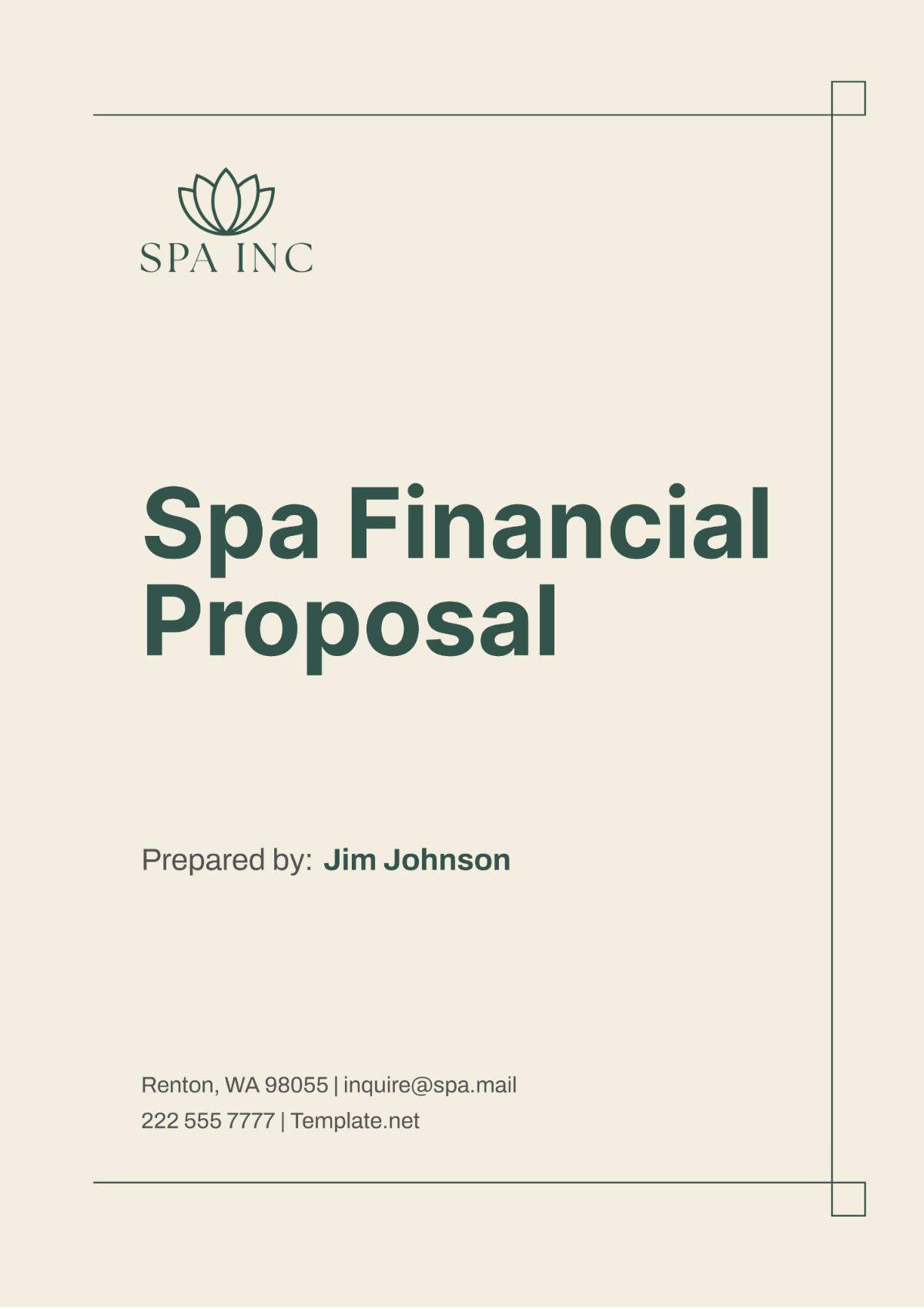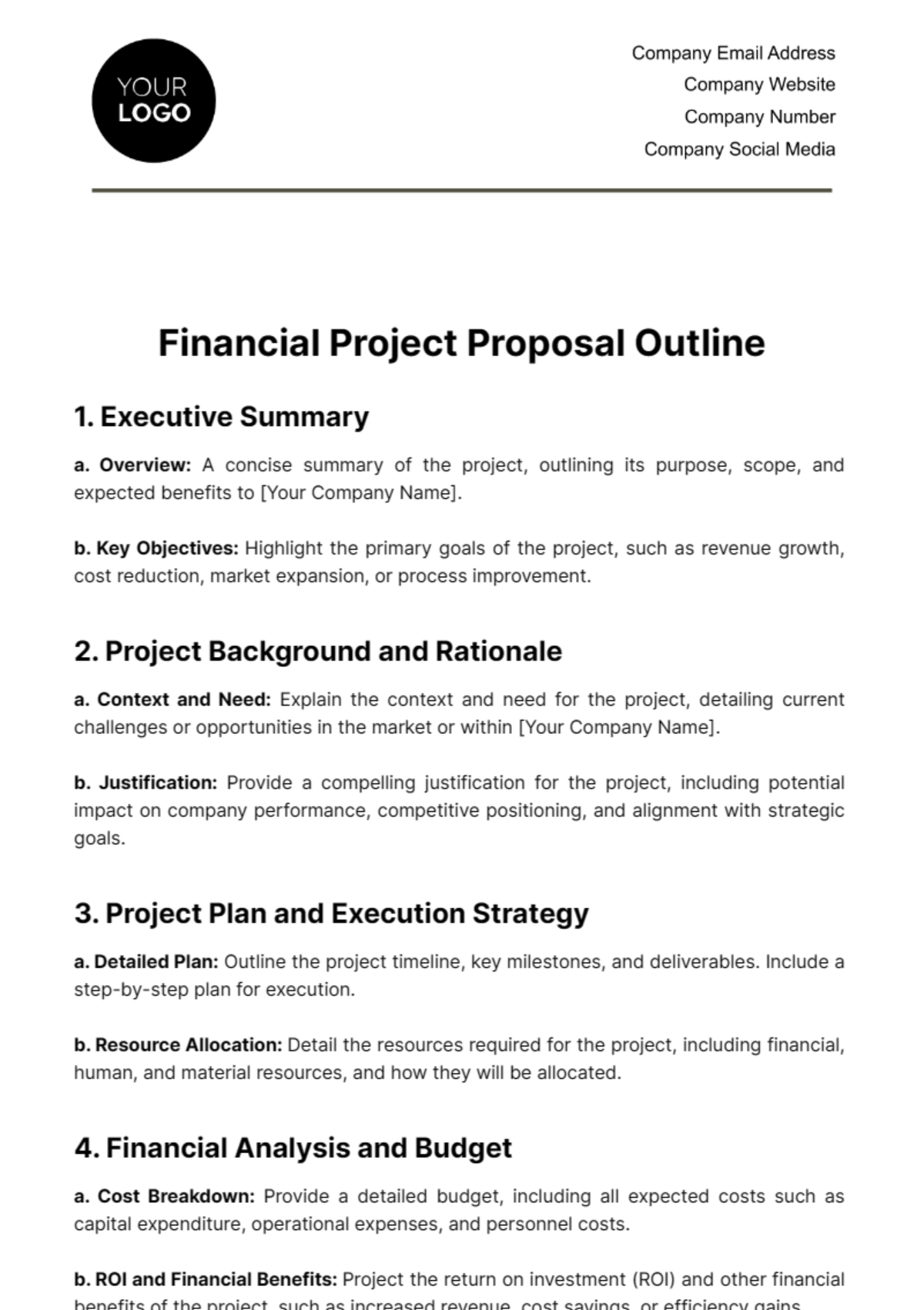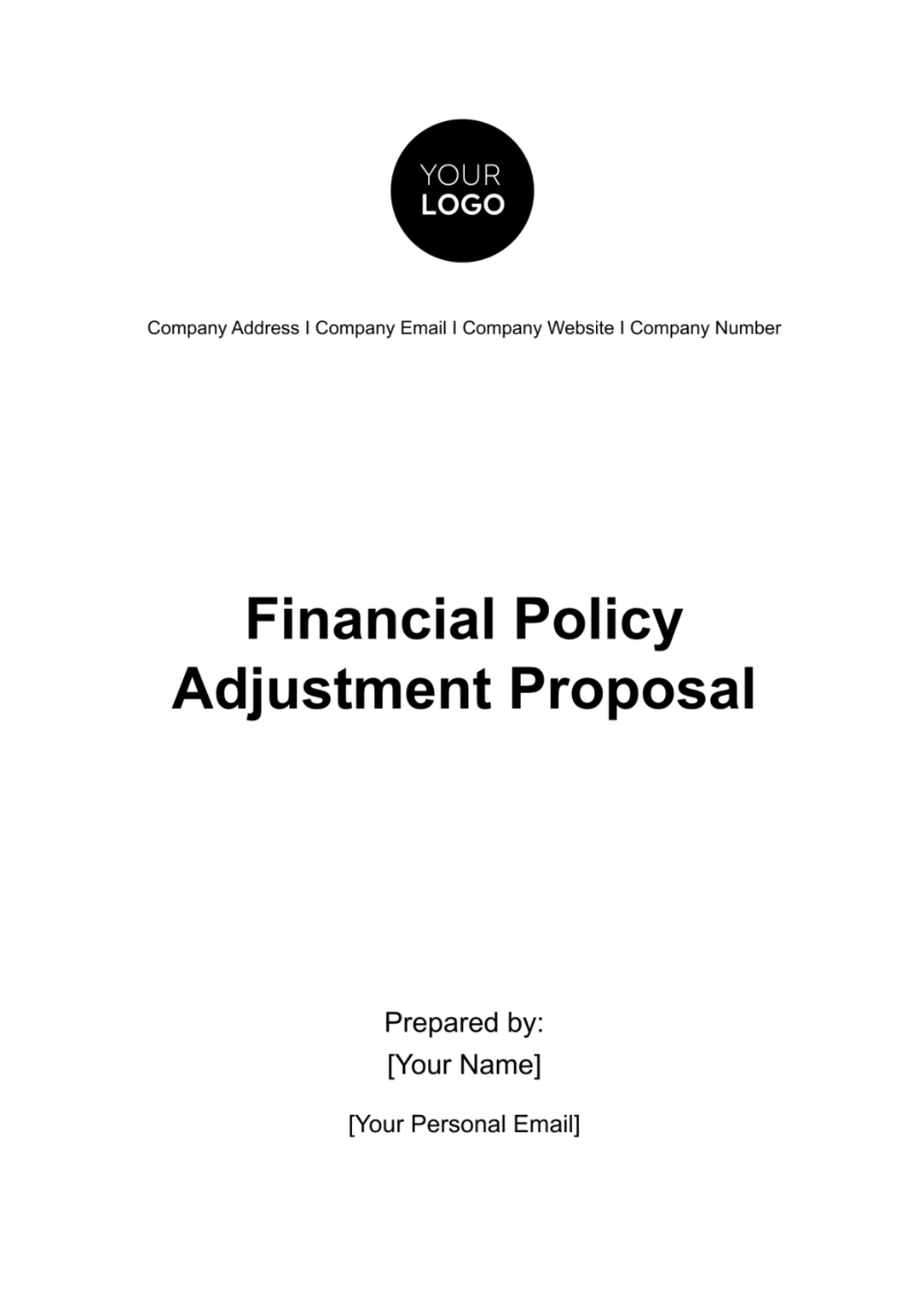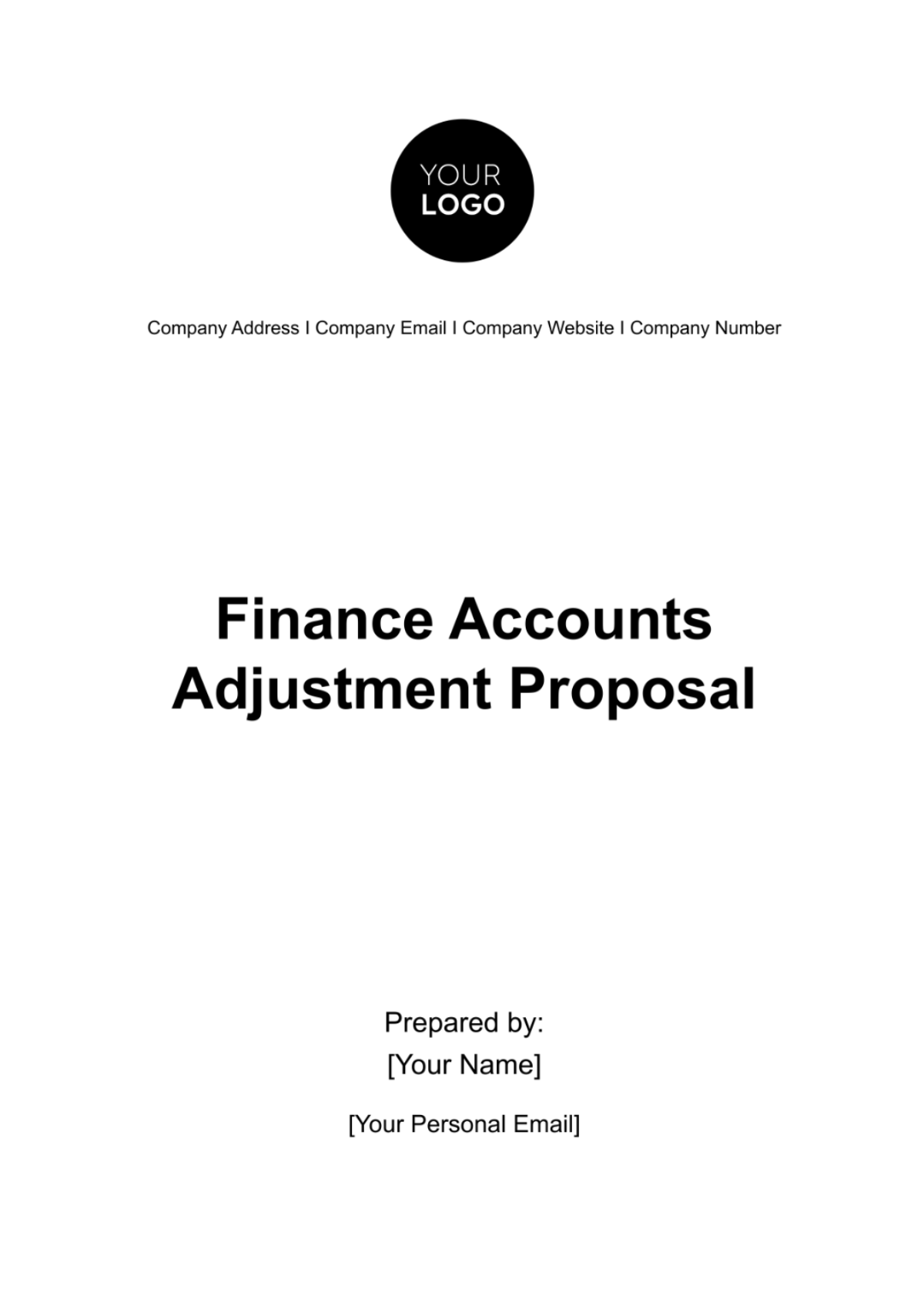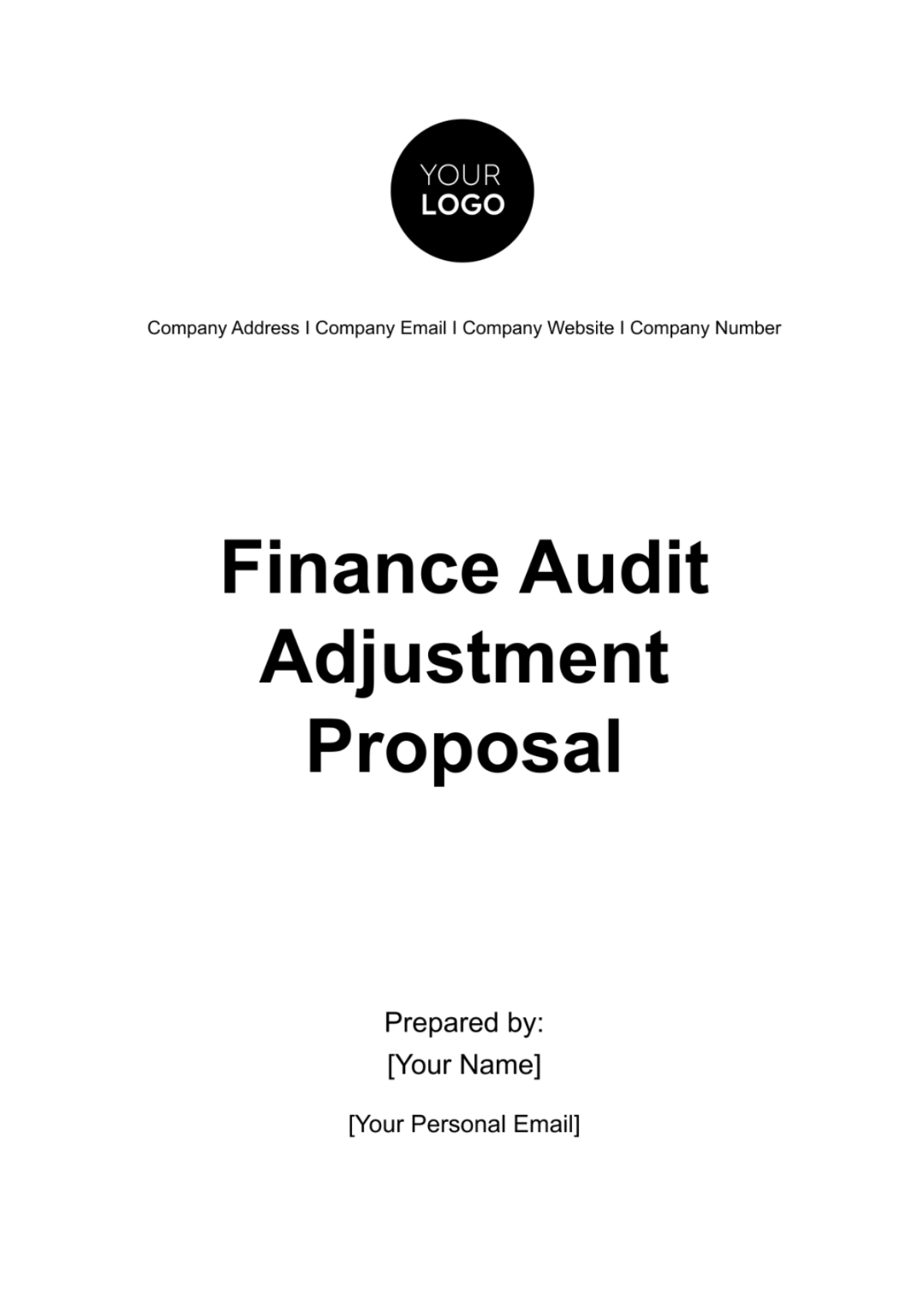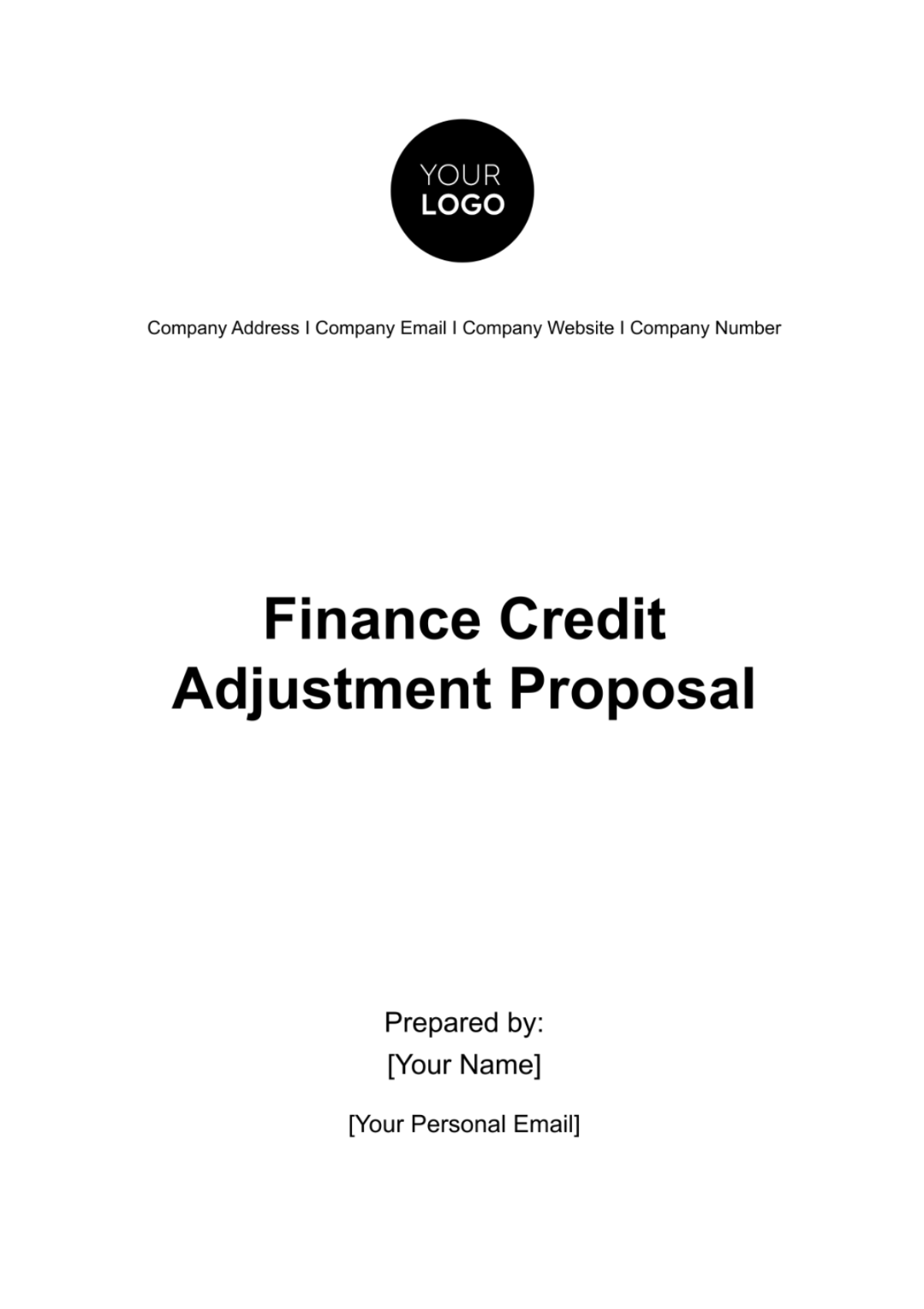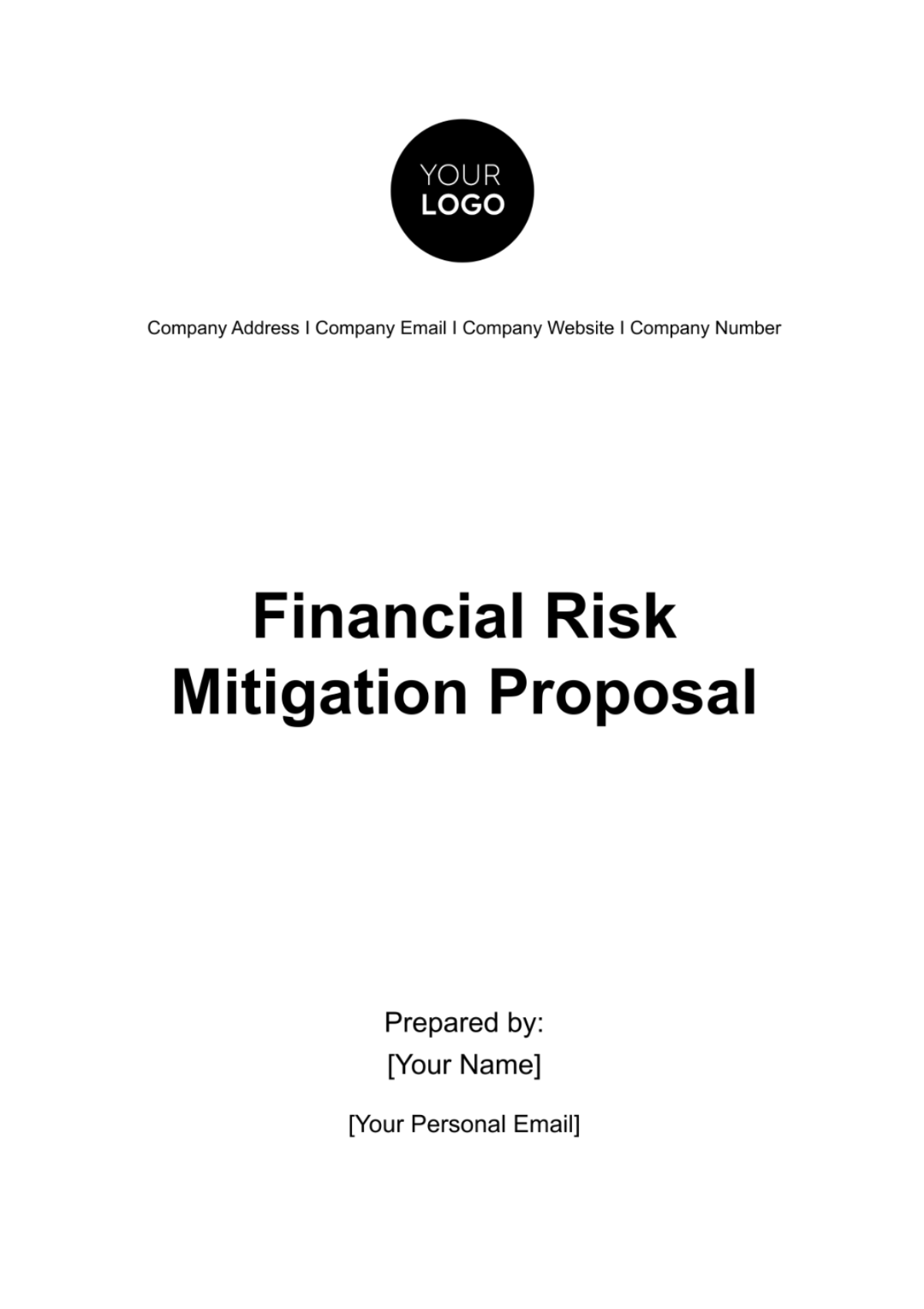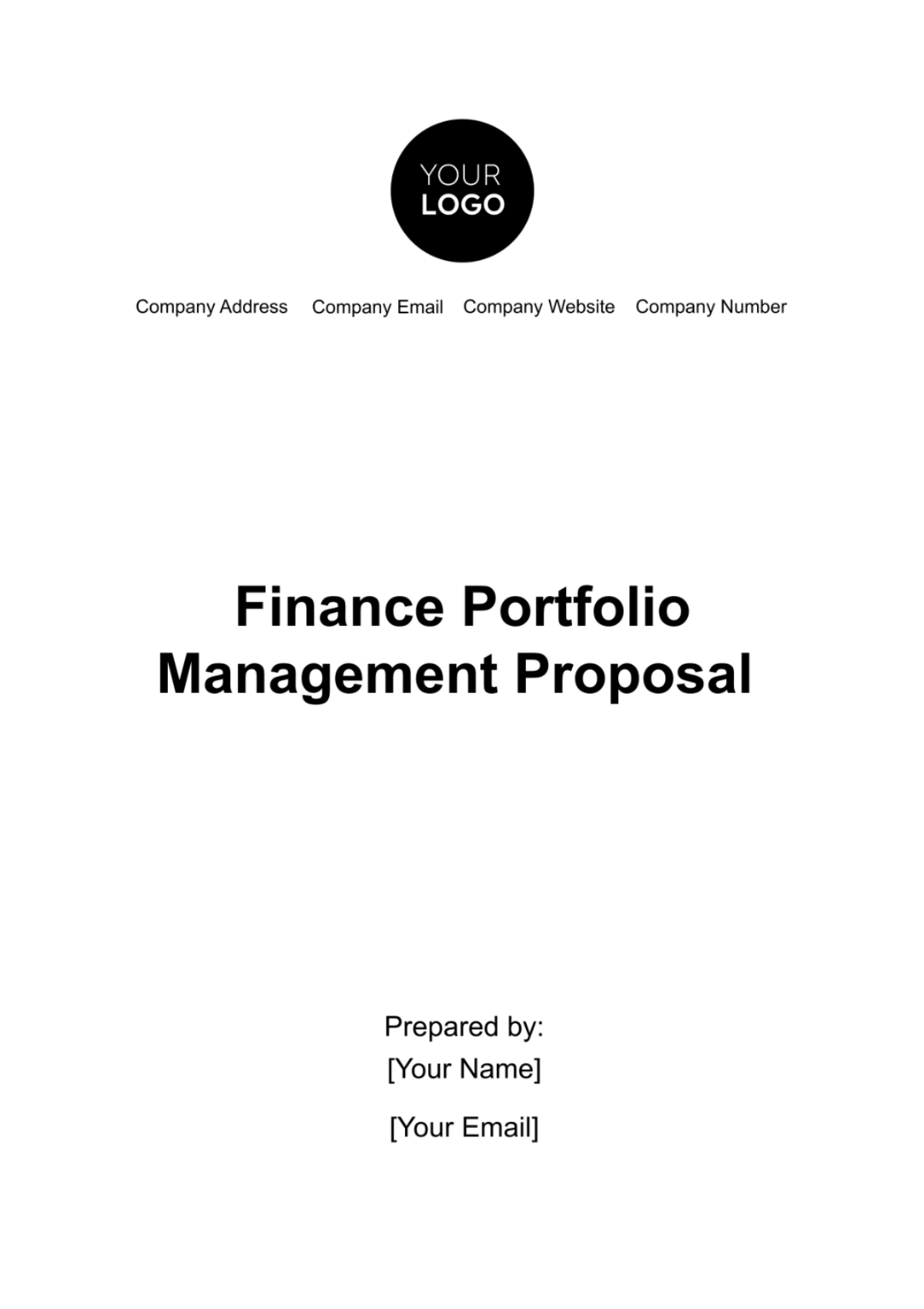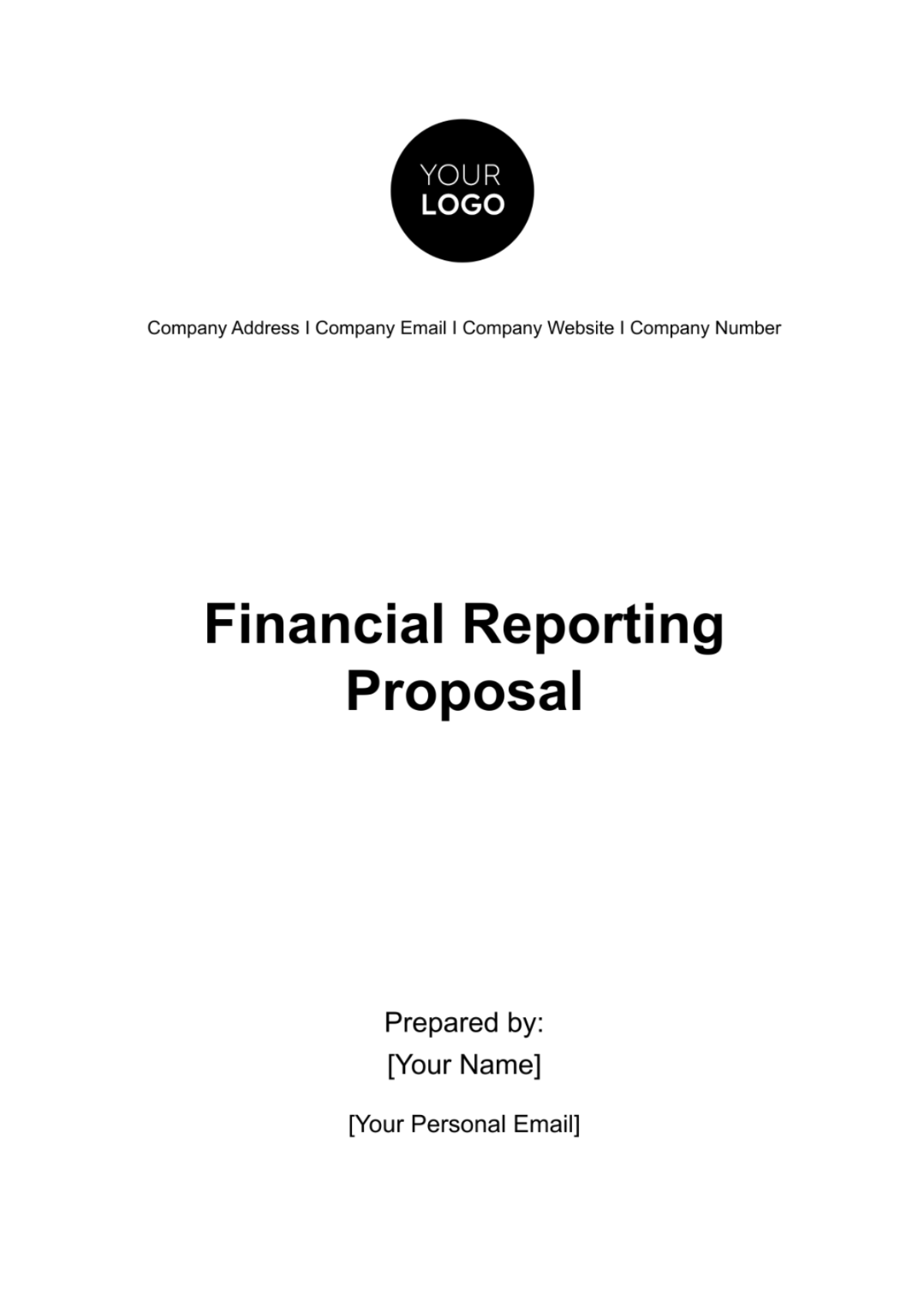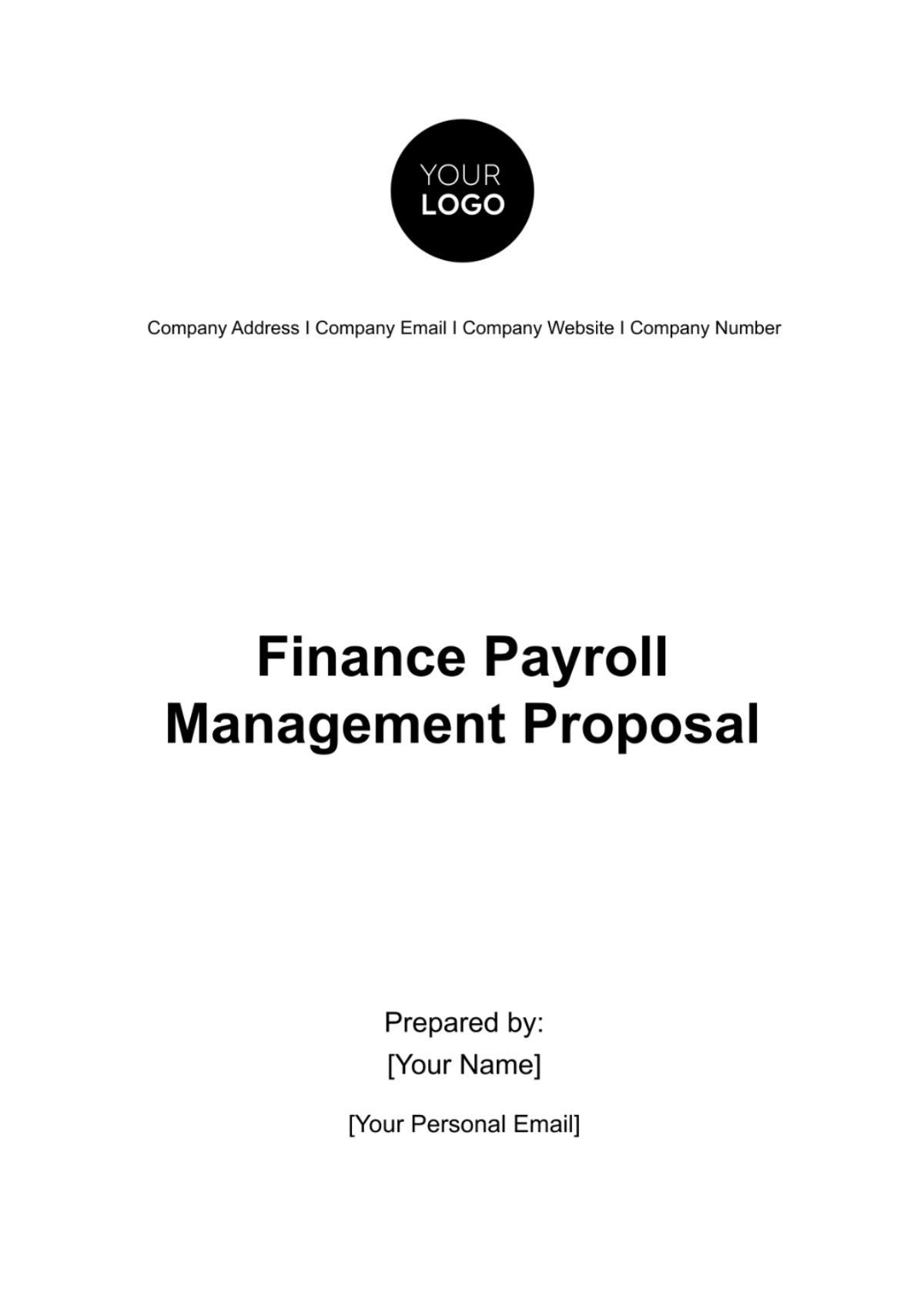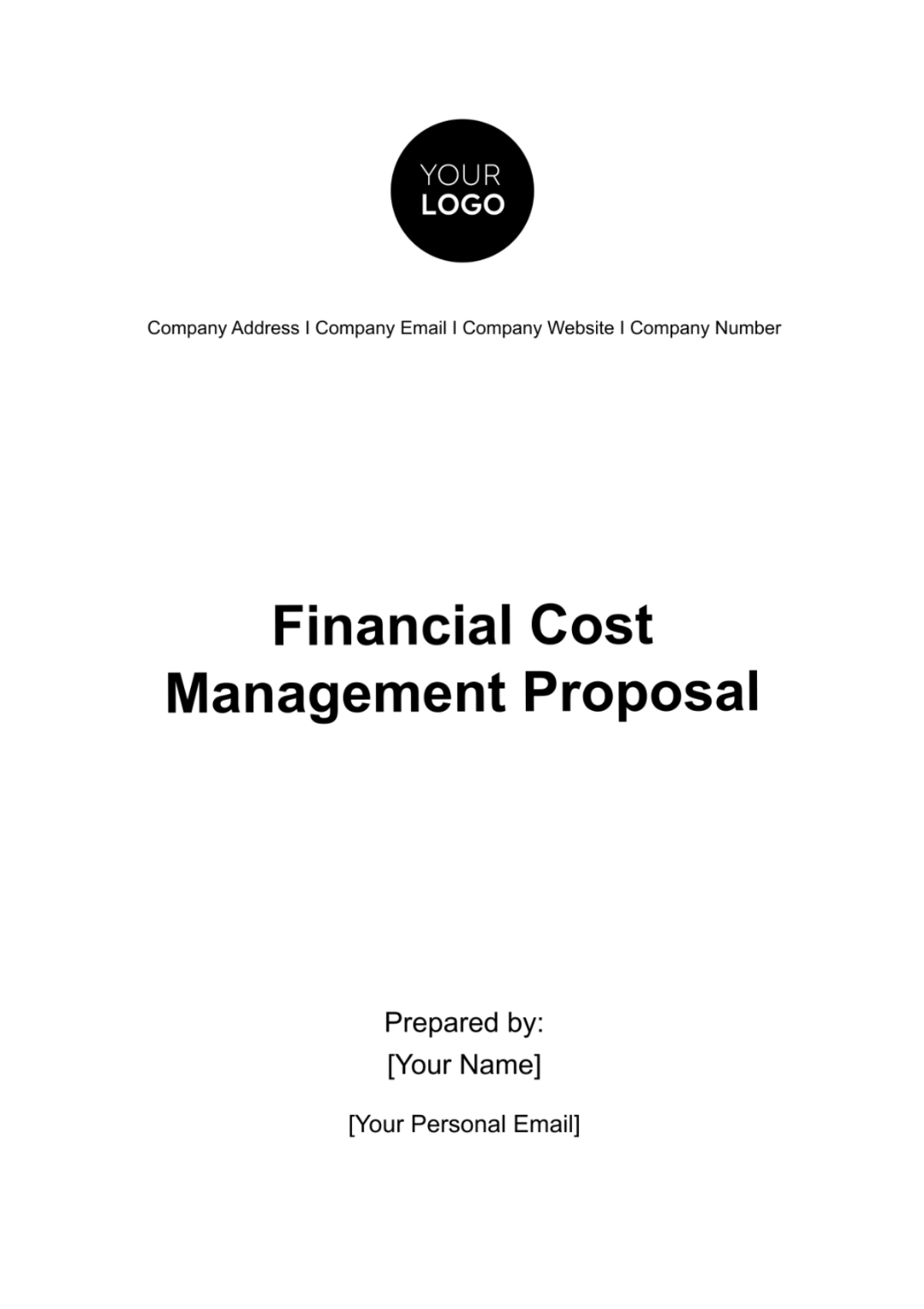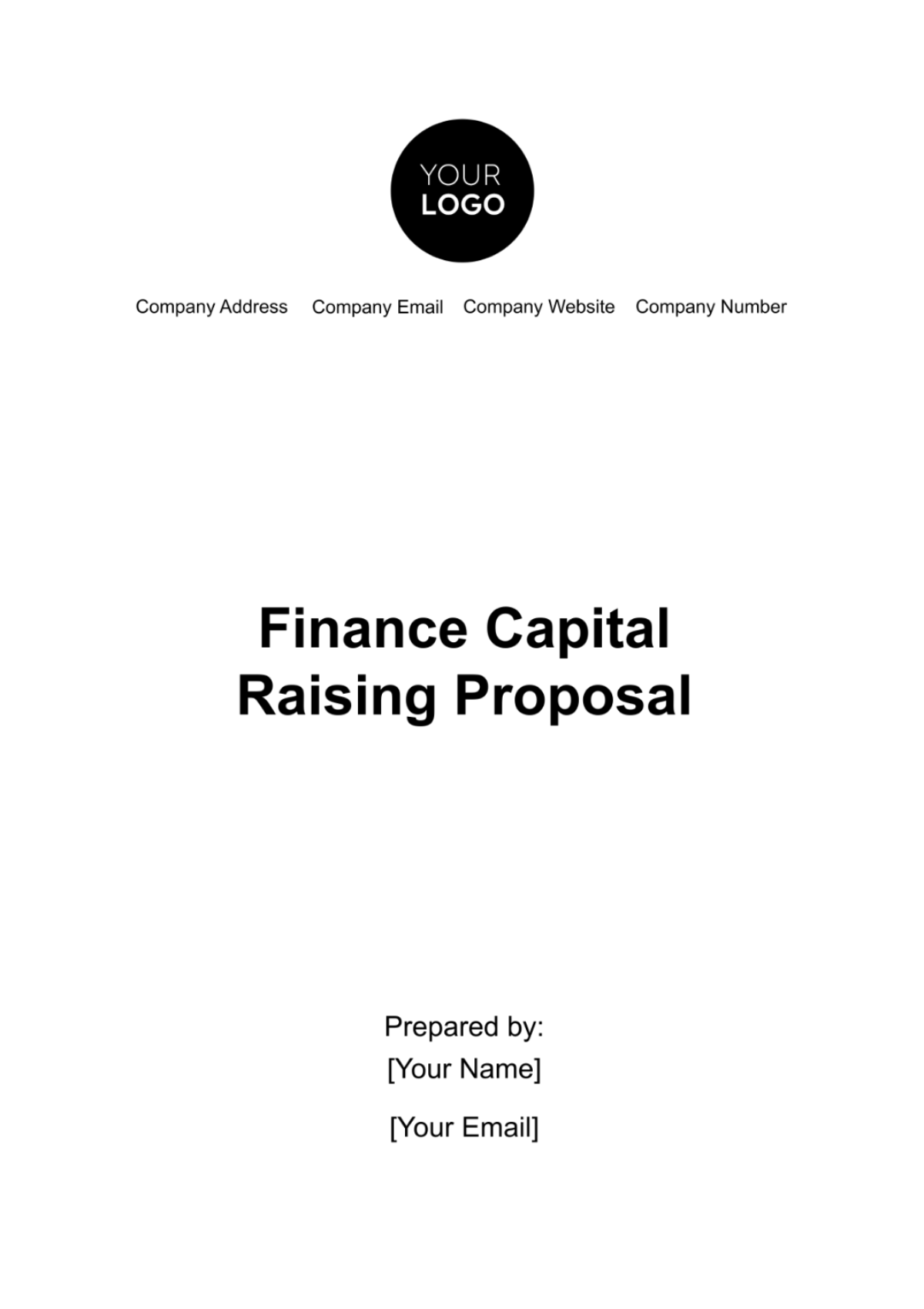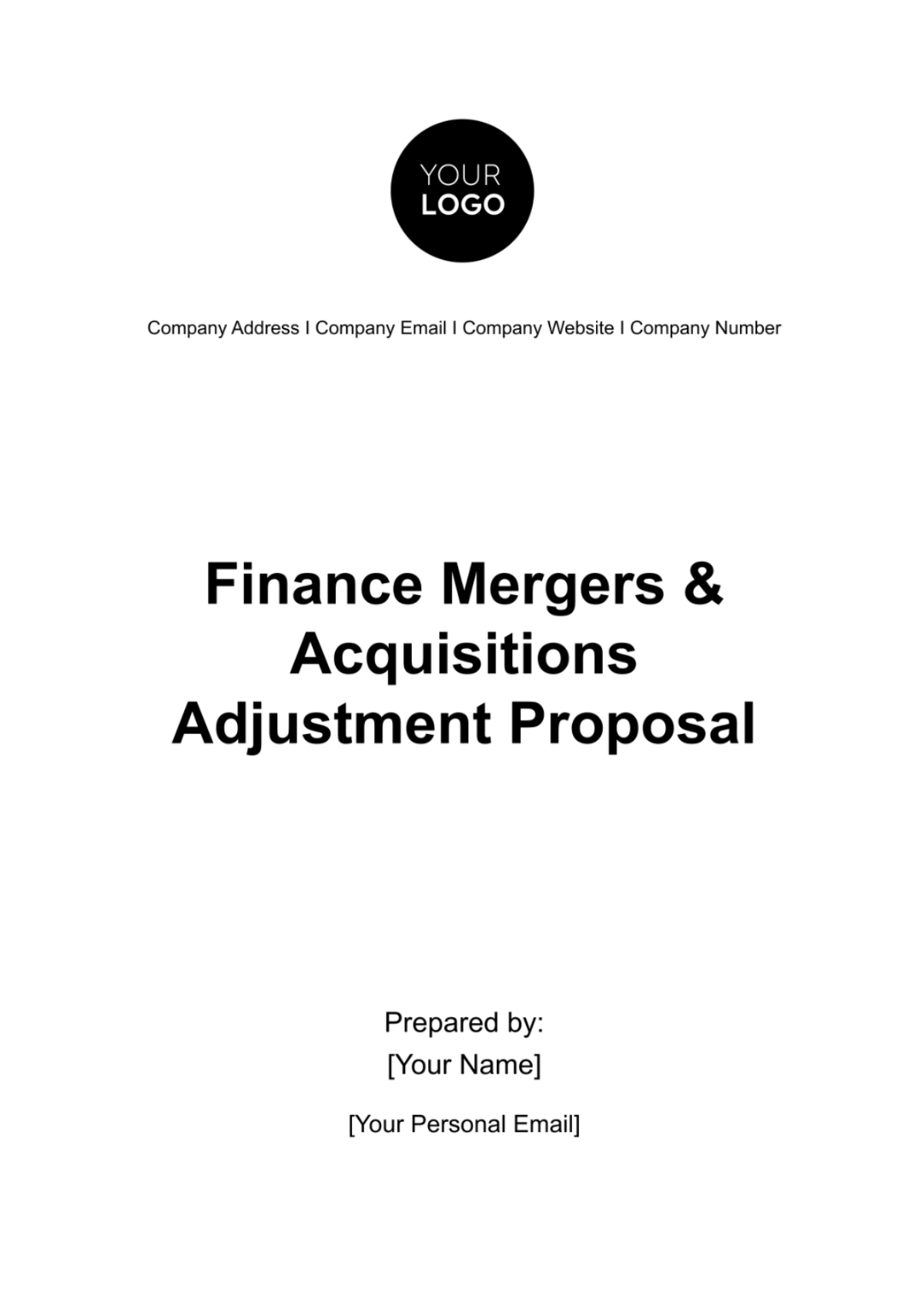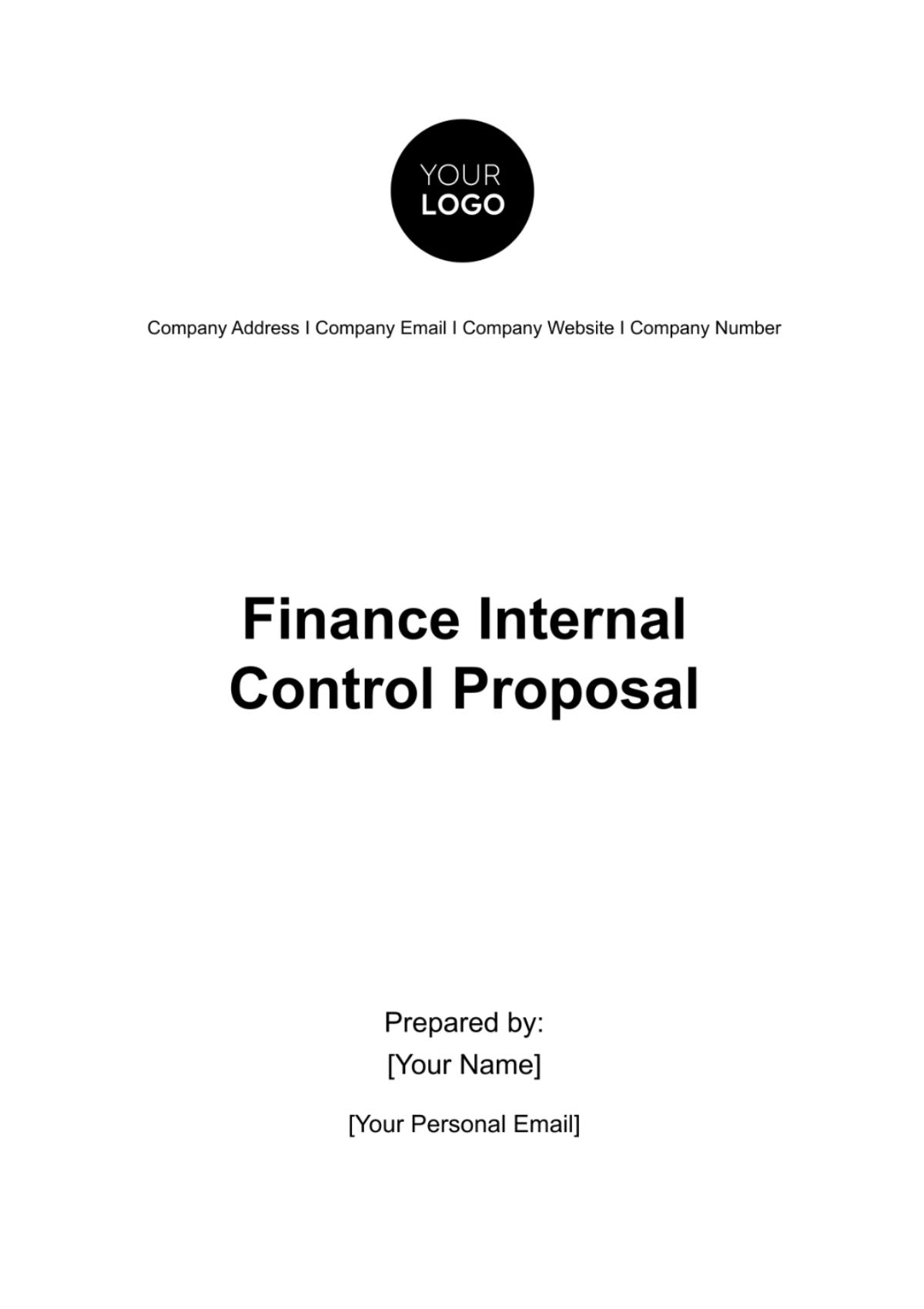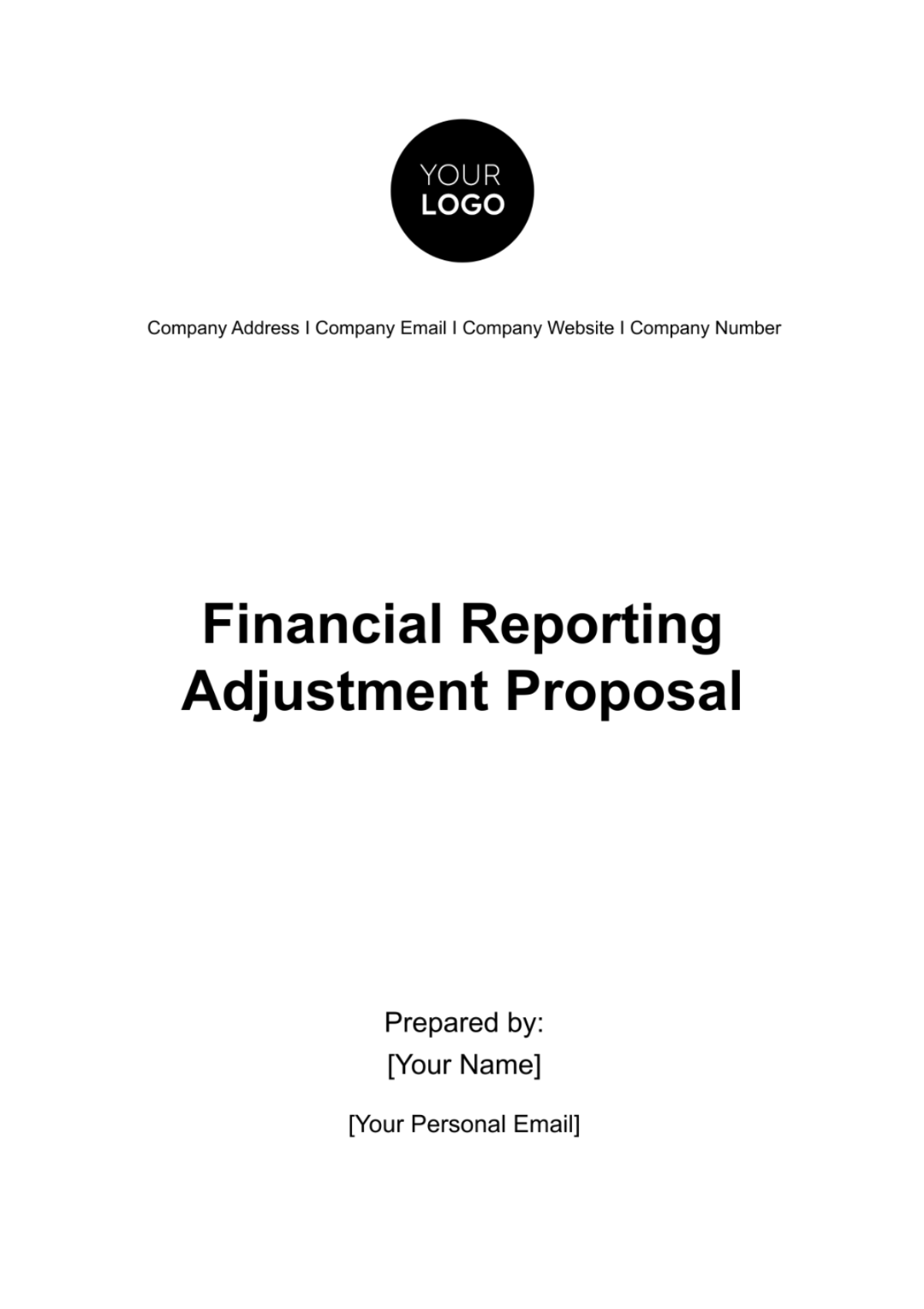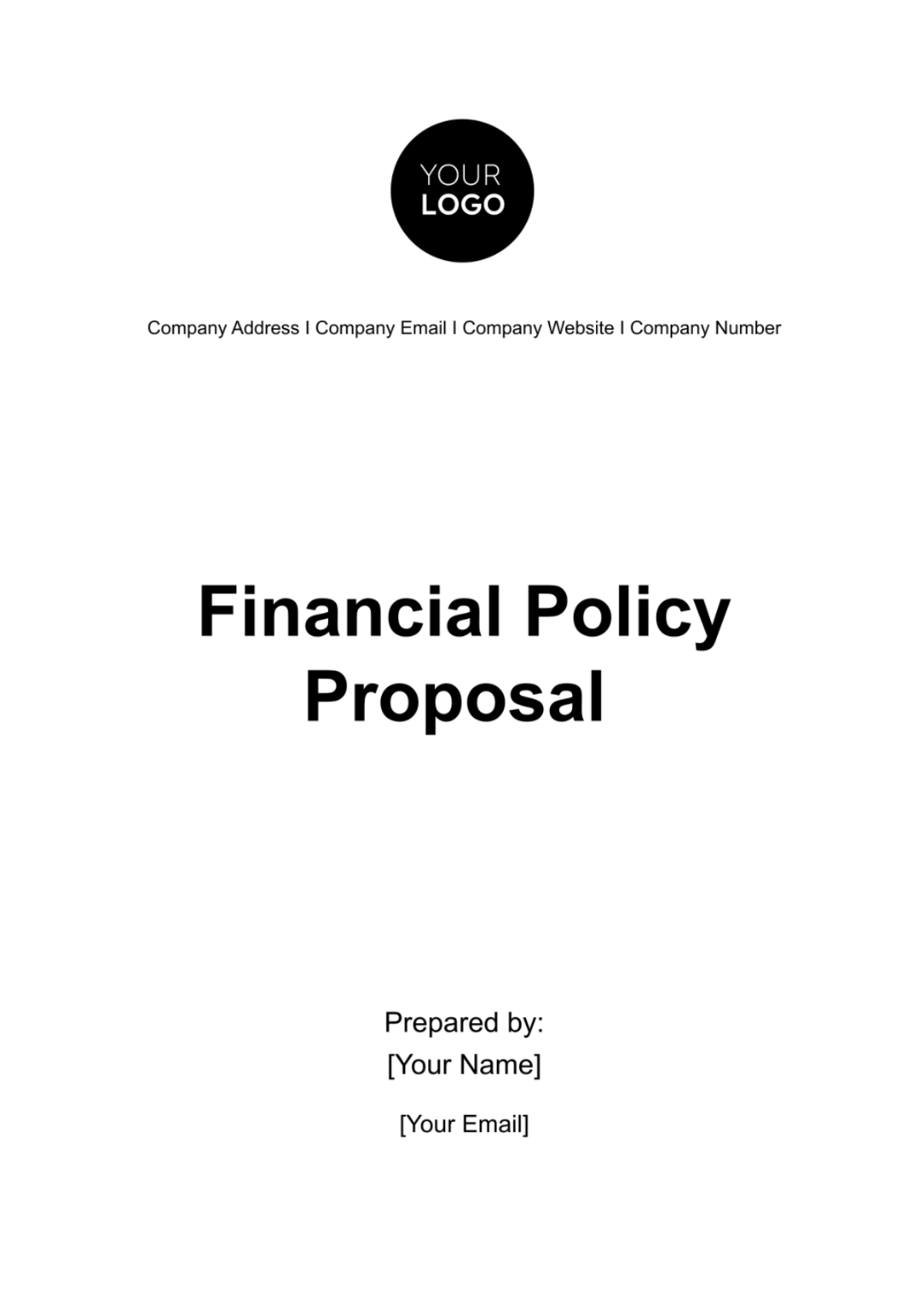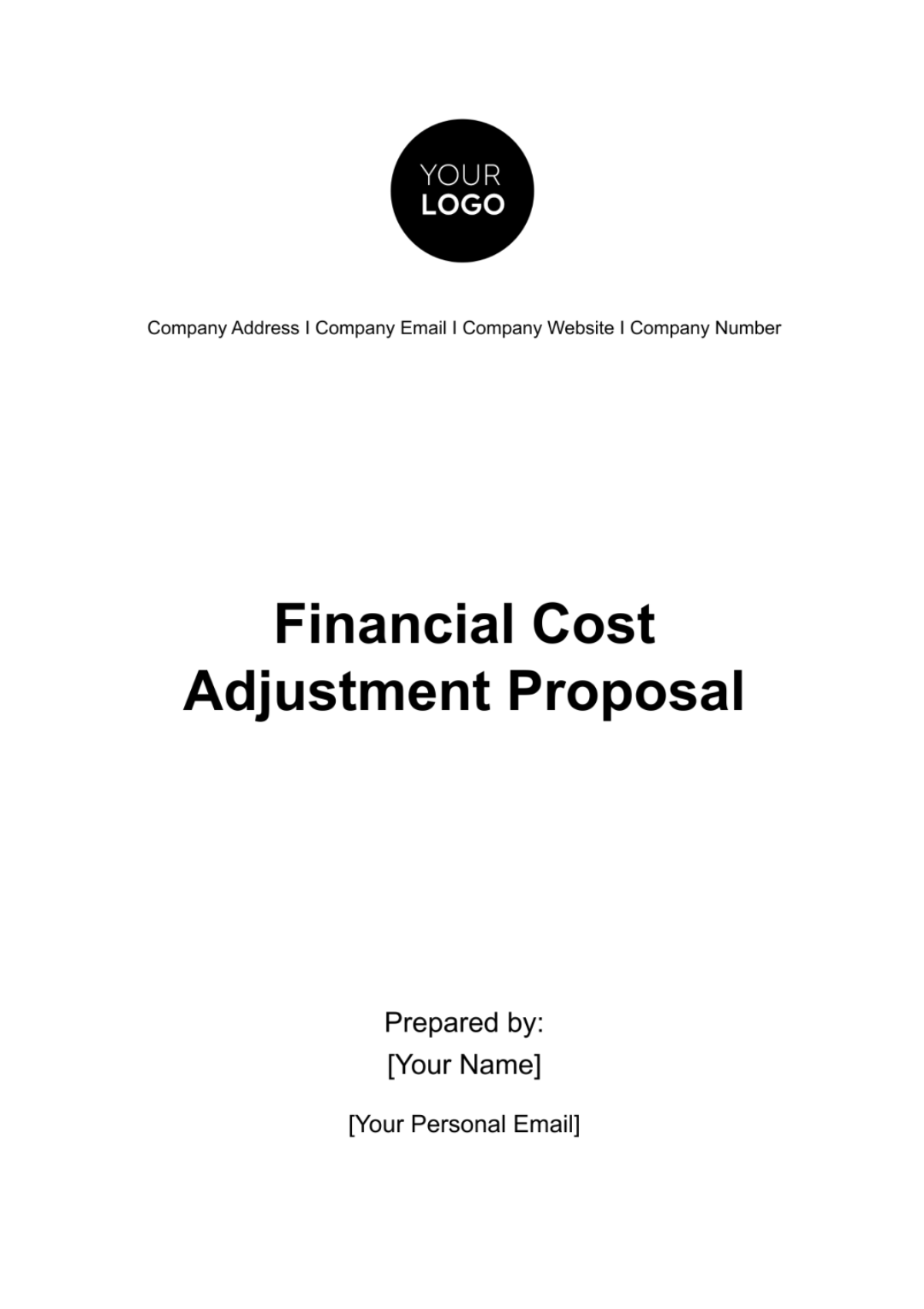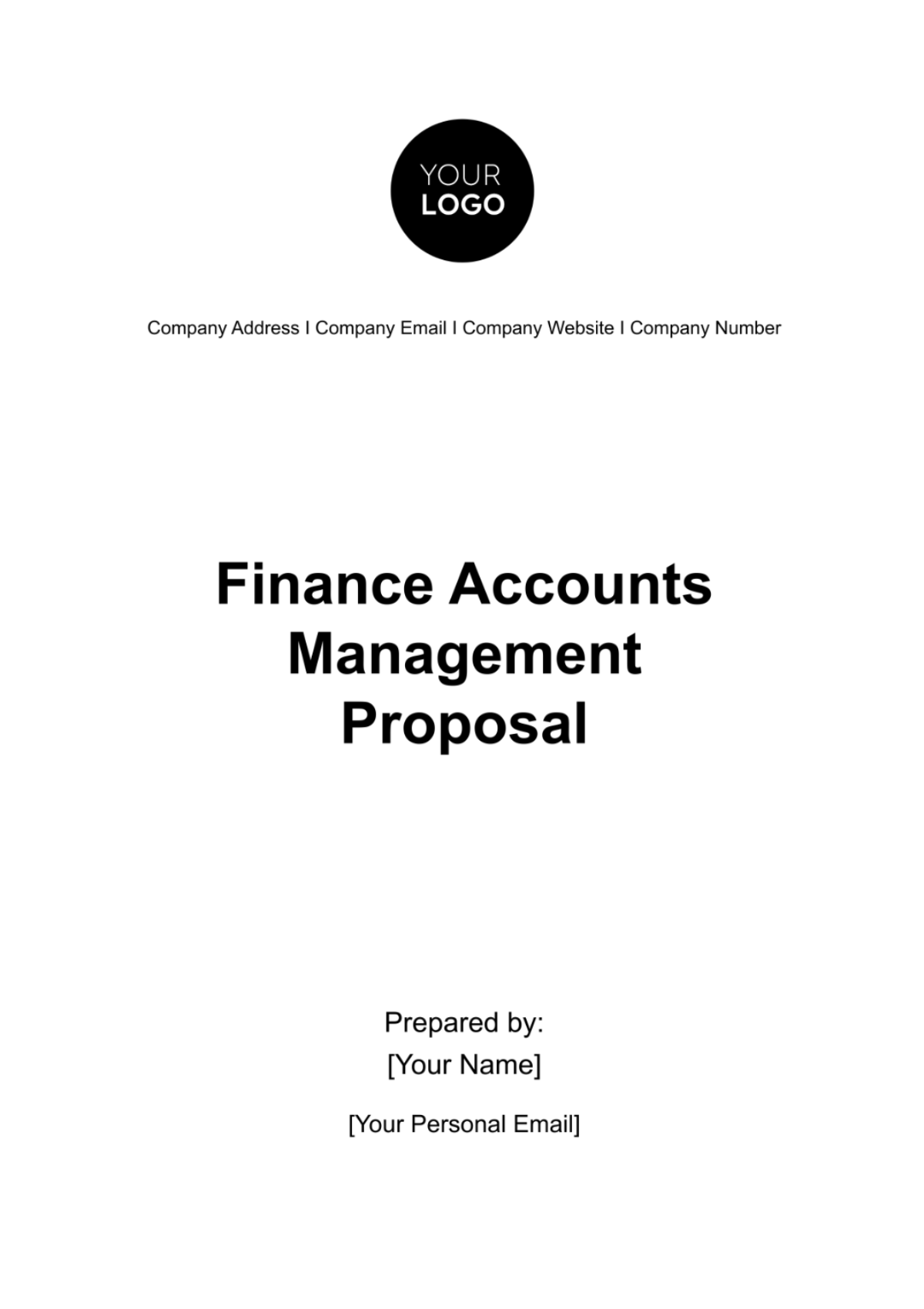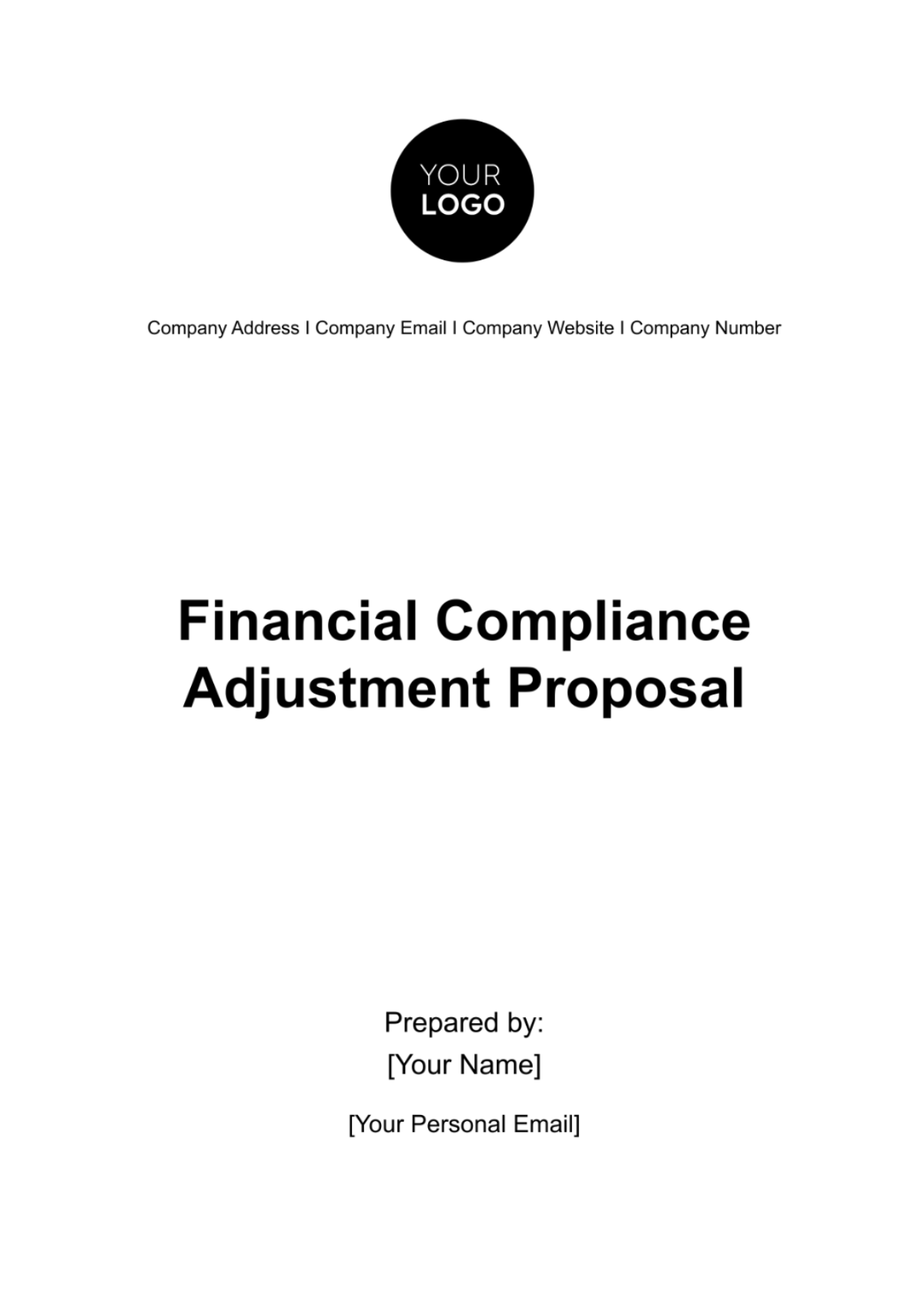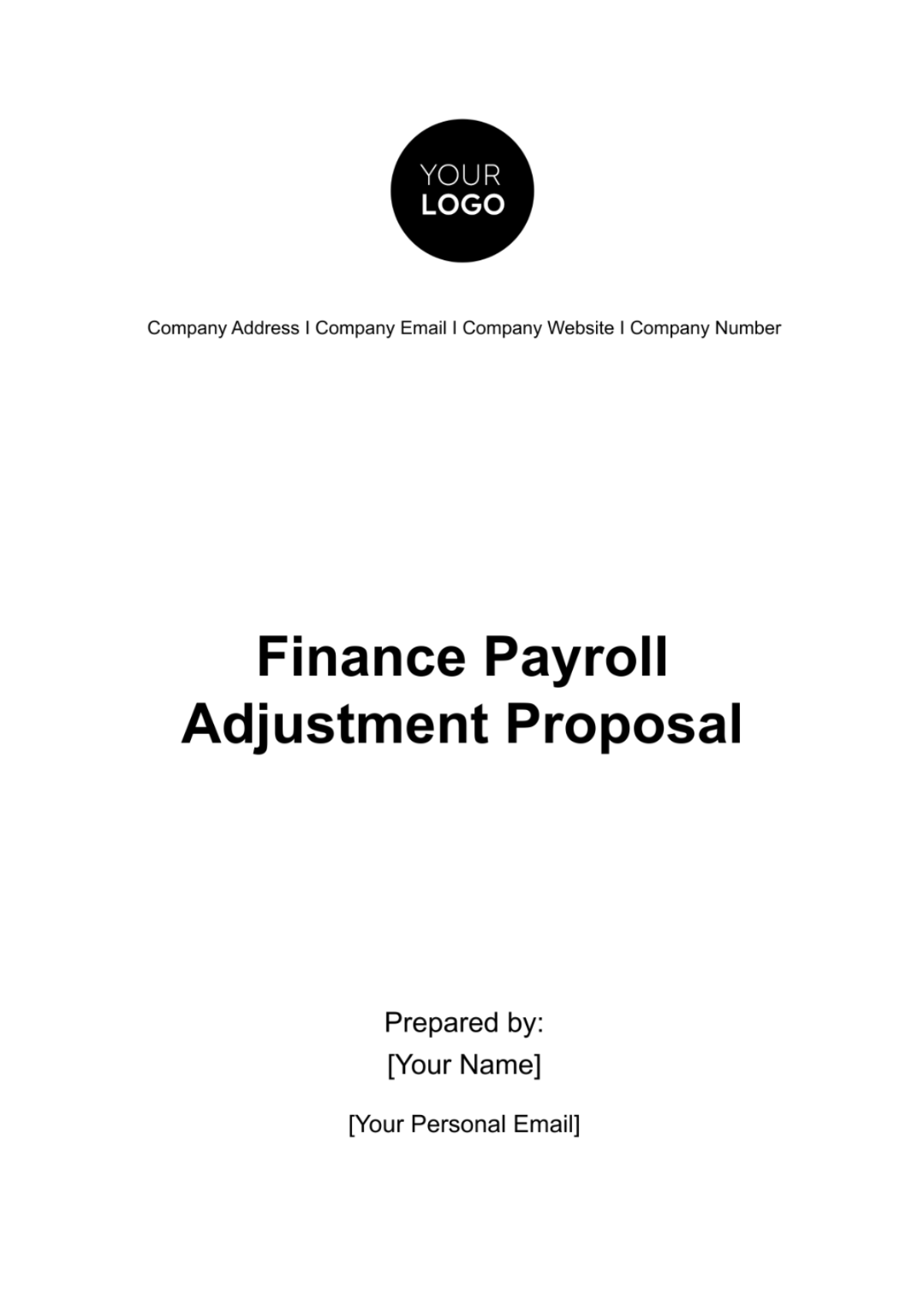Financial Advisor Proposal
I. Executive Summary
A. Purpose of the Proposal
This financial advisor proposal aims to establish a long-term partnership between [Your Company Name] and [Your Client Name]. It outlines the scope of financial advisory services that will be provided, including investment management, retirement planning, estate planning, and risk management. Our primary goal is to help [Your Client Name] achieve financial stability, growth, and security by offering personalized, objective, and actionable advice based on our extensive industry experience.
In an increasingly complex financial landscape, characterized by market volatility and regulatory changes, it is imperative to have a dedicated team of professionals guiding [Your Client Name] toward their financial goals. Our team at [Your Company Name] is equipped with the knowledge and tools necessary to navigate these challenges effectively. We are committed to ensuring that [Your Client Name]'s financial future is secure and prosperous.
B. Our Commitment
At [Your Company Name], we are committed to providing high-quality advisory services that are both timely and relevant. Our firm has a proven track record of helping clients realize their financial aspirations, regardless of market conditions or economic cycles. We believe that trust and transparency are the cornerstones of any successful advisory relationship. Therefore, our advisors are highly trained professionals who stay updated on the latest financial trends, regulatory changes, and investment opportunities.
With a focus on fiduciary responsibility, we place our clients' interests above all else. This commitment ensures that our recommendations are aligned with [Your Client Name]’s best interests, leading to informed decision-making. Our goal is not merely to achieve short-term gains but to build a robust financial foundation that supports long-term wealth accumulation.
C. Scope of Services
The scope of services offered will be tailored to [Your Client Name]'s needs. This proposal focuses on the following core areas:
Investment Management: Our team will construct a diversified portfolio designed to meet [Your Client Name]'s risk tolerance and financial goals. This includes ongoing monitoring and rebalancing to ensure alignment with market conditions.
Retirement Planning: We will create a comprehensive retirement plan that details how to achieve a sustainable income in retirement, including strategies for maximizing Social Security benefits and tax-advantaged savings vehicles.
Estate Planning: Our advisors will work with legal professionals to ensure that [Your Client Name]'s assets are distributed according to their wishes, minimizing tax liabilities and avoiding probate wherever possible.
Tax Efficiency: We will design investment strategies that minimize tax burdens and maximize after-tax returns, taking advantage of tax-deferred and tax-free investment vehicles.
Risk Management & Insurance: We will evaluate existing insurance coverage and identify any gaps that could leave [Your Client Name] vulnerable. This includes life, disability, and long-term care insurance.
Regular Financial Reviews & Adjustments: To ensure that the financial plan remains effective, we will conduct regular reviews and make adjustments as needed based on changes in [Your Client Name]'s circumstances or market conditions.
II. Understanding the Client’s Needs
A. Financial Goals
Based on preliminary discussions, we understand that [Your Client Name] is focused on the following financial goals:
Achieving a Sustainable Annual Growth Rate: Targeting a growth rate of [5%] in their investment portfolio to build wealth over time. This growth is essential for long-term financial security, especially in preparing for retirement.
Establishing a Retirement Fund: Generating an annual income of [$100,000] post-retirement, which requires careful planning and investment to ensure that this income can be maintained throughout retirement.
Minimizing Tax Liabilities: Implementing strategies to reduce tax liabilities, allowing more of [Your Client Name]'s income and returns to be reinvested for future growth.
Creating a Plan for Estate Succession: Establishing a comprehensive estate plan to minimize probate costs and ensure that [Your Client Name]’s assets are passed on to heirs efficiently, safeguarding family wealth for generations to come.
B. Risk Tolerance
Our risk assessment shows that [Your Client Name] is moderately conservative, preferring stable returns with limited exposure to volatile markets. They are willing to accept some level of risk, but priority is given to the preservation of capital. Understanding risk tolerance is critical as it directly impacts investment decisions. Therefore, we will ensure that the portfolio reflects this risk appetite, balancing growth potential with capital preservation.
C. Current Financial Standing
A detailed analysis of [Your Client Name]'s financial position shows the following:
Asset Class | Current Value | Target Value by 2060 |
|---|---|---|
Total Investable Assets | [$1,500,000] | [$3,500,000] |
Real Estate | [$750,000] | [$1,000,000] |
Retirement Accounts (401k) | [$500,000] | [$2,000,000] |
Taxable Accounts | [$250,000] | [$1,000,000] |
This table illustrates a significant gap between current assets and desired future values. We recognize that [Your Client Name] will need to implement effective investment strategies to bridge this gap and meet their financial objectives.
D. Identified Gaps
Several financial gaps and opportunities have been identified based on the current assessment:
Lack of Diversification: The current investment portfolio shows a heavy allocation toward real estate, which leaves it vulnerable to market fluctuations. A diversified portfolio will mitigate risk and enhance returns by including a mix of asset classes.
Underfunded Retirement Accounts: With a target retirement income of [$100,000], the current retirement accounts are insufficient. A gap of approximately [$1,500,000] is identified to meet post-retirement income goals. This gap highlights the need for increased contributions and effective investment strategies.
Insufficient Estate Planning Measures: Currently, there are no formal plans in place for estate succession, leading to potential complications and costs in the event of unforeseen circumstances. Establishing a comprehensive estate plan will ensure that [Your Client Name]’s wishes are honored while minimizing taxes and legal costs.
III. Investment Strategy
A. Portfolio Allocation
Our proposed portfolio allocation is designed to align with [Your Client Name]'s risk tolerance and financial goals. We recommend diversifying across multiple asset classes to minimize risk while maximizing returns over the long term.
Asset Class | Target Allocation (%) | Expected Annual Return (%) |
|---|---|---|
Equities | [50%] | [6-8%] |
Bonds | [30%] | [2-4%] |
Real Estate | [10%] | [3-5%] |
Alternative Assets | [10%] | [7-10%] |
This strategic asset allocation provides a balanced approach to growth while managing risk. Equities offer the highest potential return, while bonds provide stability and income. Real estate serves as a hedge against inflation, and alternative assets provide diversification benefits.
B. Investment Vehicles
We propose the following investment vehicles to implement the asset allocation plan:
Equities: We will invest in a mix of exchange-traded funds (ETFs) and mutual funds that focus on both domestic and international markets. We will also explore opportunities in growth sectors like technology, healthcare, and renewable energy. For example, investing in a technology-focused ETF could yield an average annual return of [8%].
Bonds: A mix of government and corporate bonds to provide a stable income stream with minimal risk. This can include U.S. Treasury bonds and investment-grade corporate bonds, projected to return around [3%].
Real Estate: Utilizing real estate investment trusts (REITs) to capitalize on property markets without the burden of direct management. REITs typically offer attractive yields of around [4%].
Alternative Assets: Investments in hedge funds, private equity, and commodities can yield higher returns. For instance, hedge funds might target returns of [10%] but carry additional risk.
C. Expected Returns
Based on our analysis, we project the following returns on the investment portfolio, illustrating growth over time:
This projected growth demonstrates the power of compounding and effective asset management. The table illustrates how [Your Client Name]'s investments can potentially grow over time if the recommended strategies are implemented and adhered to.
D. Rebalancing Strategy
Regular portfolio rebalancing will be crucial in maintaining the desired asset allocation. We propose quarterly reviews to evaluate market performance and make any necessary adjustments. By rebalancing, we ensure that the portfolio does not deviate significantly from its target allocation, which can help mitigate risk and optimize returns.
In addition, strategic reallocation during major life events, such as retirement, the birth of a child, or significant market disruptions, will ensure the portfolio remains aligned with [Your Client Name]’s financial objectives. For instance, if equities outperform significantly, we may need to sell some equity positions and reinvest in bonds or other asset classes to maintain the target allocation.
IV. Retirement Planning
A. Retirement Income Projections
[Your Client Name] has indicated a need for an annual retirement income of [$100,000] starting in [2065]. To achieve this, we propose a detailed savings and investment plan, which will include contributions to tax-advantaged retirement accounts.
Retirement Account | Current Balance ($) | Expected Growth Rate (%) | Future Value ($) |
|---|---|---|---|
401(k) | [$500,000] | [6%] | [$1,800,000] |
IRA | [$200,000] | [6%] | [$720,000] |
Roth IRA | [$300,000] | [6%] | [$1,080,000] |
The table above illustrates how [Your Client Name]'s current retirement accounts can grow over the years, assuming consistent contributions and market performance.
B. Contribution Strategy
To reach the required retirement fund, we recommend the following contribution strategy:
Maximizing 401(k) Contributions: Aim to contribute the maximum allowed by law, currently [$20,500] annually, with an additional [$6,500] catch-up contribution after age [50].
Utilizing an IRA: Contribute the maximum allowed to both Traditional and Roth IRAs, taking advantage of the tax benefits each provides.
Investment Growth: Reinvest dividends and interest to maximize compounding. This strategy can significantly increase the overall value of the retirement accounts over time.
C. Social Security Optimization
Understanding the complexities of Social Security benefits is essential for maximizing retirement income. We will analyze [Your Client Name]'s work history to determine the optimal age to begin taking benefits. Strategies may include delaying benefits until age [70] to receive the maximum monthly payment.
D. Withdrawal Strategy
An effective withdrawal strategy is crucial to ensure that [Your Client Name] can maintain their desired lifestyle in retirement. We will establish a plan that details:
Order of Withdrawals: Determine the sequence of withdrawals from taxable, tax-deferred, and tax-free accounts to minimize taxes over time.
Sustainable Withdrawal Rate: Adopting a conservative withdrawal rate of [4%] annually can help extend the longevity of [Your Client Name]'s retirement savings.
Flexibility: Adapting the withdrawal strategy based on market conditions and personal spending needs will be vital in preserving capital throughout retirement.
V. Tax Efficiency
A. Tax Planning Strategies
To minimize tax liabilities, we will implement several strategies:
Tax-Loss Harvesting: Selling underperforming investments to offset capital gains from profitable investments, thereby reducing taxable income.
Utilizing Tax-Advantaged Accounts: Maximizing contributions to 401(k)s, IRAs, and Health Savings Accounts (HSAs) to defer or eliminate taxes on contributions and earnings.
Long-Term Capital Gains: Encouraging long-term investments to take advantage of lower tax rates on long-term capital gains, compared to short-term gains.
B. Projected Tax Savings
By implementing these strategies, we anticipate significant tax savings over the investment period. The projected savings can be outlined as follows:
Strategy | Estimated Annual Savings ($) |
|---|---|
Tax-Loss Harvesting | [$5,000] |
Maximizing Tax-Advantaged Accounts | [$10,000] |
Long-Term Capital Gains Strategy | [$7,500] |
Total projected annual tax savings would amount to approximately [$22,500]. This could be reinvested, leading to further portfolio growth.
C. Collaboration with Tax Professionals
We will collaborate with tax professionals to ensure that [Your Client Name] benefits from the latest tax laws and regulations. By staying informed, we can adapt our strategies as needed, ensuring that tax efficiency is maintained.
VI. Risk Management and Insurance
A. Insurance Needs Assessment
A thorough assessment of [Your Client Name]'s current insurance coverage will be conducted to identify potential gaps and areas for improvement. This will include evaluating:
Life Insurance: Ensuring that there is adequate life insurance coverage to protect dependents and cover outstanding debts. The recommended coverage should equal [10-12 times] annual income to provide sufficient support.
Disability Insurance: Reviewing existing disability insurance to ensure it covers at least [60%] of pre-disability income, safeguarding against unexpected loss of income.
Long-Term Care Insurance: Considering long-term care insurance as a preventative measure against high costs associated with nursing homes or assisted living, which can average [$100,000] per year.
B. Recommendations for Coverage
After assessing current coverage levels, we recommend the following coverage amounts:
Insurance Type | Current Coverage ($) | Recommended Coverage ($) |
|---|---|---|
Life Insurance | [$500,000] | [$1,500,000] |
Disability Insurance | [$2,500/month] | [$5,000/month] |
Long-Term Care Insurance | [N/A] | [$300,000] |
This table provides a clear comparison between current and recommended coverage levels, illustrating the need for adjustments in insurance policies to ensure comprehensive risk management.
C. Estate Planning Considerations
Our risk management strategy also includes estate planning considerations. We will work closely with legal professionals to ensure that [Your Client Name] has an up-to-date will and power of attorney. Additionally, we will discuss the benefits of establishing trusts to protect assets and facilitate the transfer of wealth to beneficiaries.
VII. Regular Financial Reviews and Adjustments
A. Quarterly Financial Reviews
To ensure that [Your Client Name]’s financial plan remains on track, we will conduct quarterly reviews. These reviews will include:
Performance Assessment: Analyzing the performance of investments against benchmarks and making adjustments as necessary to optimize returns.
Goal Review: Revisiting financial goals and ensuring they remain aligned with [Your Client Name]'s life changes and market conditions.
Rebalancing Recommendations: Evaluating the portfolio’s asset allocation and recommending adjustments to maintain the target allocation as outlined previously.
B. Annual Comprehensive Review
An annual comprehensive review will provide a more in-depth evaluation of the overall financial plan. This review will cover:
Retirement Plan Analysis: Assessing progress toward retirement income goals and adjusting strategies based on changes in retirement dates or income needs.
Estate Plan Evaluation: Ensuring that the estate plan remains aligned with [Your Client Name]’s wishes and current laws.
Tax Strategy Review: Analyzing the effectiveness of tax strategies implemented throughout the year and adjusting for upcoming tax law changes.
C. Adjustment Strategy
Based on the findings from quarterly and annual reviews, we will implement an adjustment strategy that includes:
Portfolio Reallocation: Moving assets among different investments to optimize performance while maintaining risk levels aligned with [Your Client Name]'s goals.
Revising Contribution Levels: Adjusting contribution levels to retirement and other accounts based on performance and life changes, such as job changes or income fluctuations.
Estate Planning Updates: Making necessary updates to wills, trusts, and beneficiary designations based on life events like marriage, divorce, or the birth of a child.
VIII. Fee Structure
A. Advisory Fees
Our fee structure is transparent and designed to align our interests with those of [Your Client Name]. We charge an annual fee based on a percentage of assets under management (AUM). The fee structure is as follows:
AUM Bracket ($) | Annual Fee (%) |
|---|---|
[$0 - $1,000,000] | [1.0%] |
[$1,000,001 - $3,000,000] | [0.85%] |
[$3,000,001 - $5,000,000] | [0.75%] |
[$5,000,001+] | [0.5%] |
This tiered fee structure is designed to reward larger portfolios while ensuring that [Your Client Name] receives high-quality, personalized service.
B. Additional Costs
In addition to the advisory fees, there may be additional costs for specialized services such as estate planning, tax preparation, or complex investment strategies. These will be clearly communicated upfront, and we will ensure that [Your Client Name] understands all potential costs involved.
IX. Conclusion
[Your Company Name] is dedicated to helping [Your Client Name] achieve their financial goals through a comprehensive and personalized advisory service. We believe that a strategic, holistic approach to financial planning is essential in today's complex economic landscape.
By utilizing a structured approach that includes investment management, retirement planning, tax efficiency, and risk management, we aim to provide long-term financial security and peace of mind. We are committed to being a trusted partner on [Your Client Name]'s financial journey, continuously adapting and adjusting strategies to meet evolving needs and circumstances.
We look forward to the opportunity to work together and build a lasting financial partnership that benefits both [Your Client Name] and future generations. Please feel free to reach out with any questions or for further clarification on any points discussed in this proposal. Together, we can embark on a path toward financial empowerment and success.



